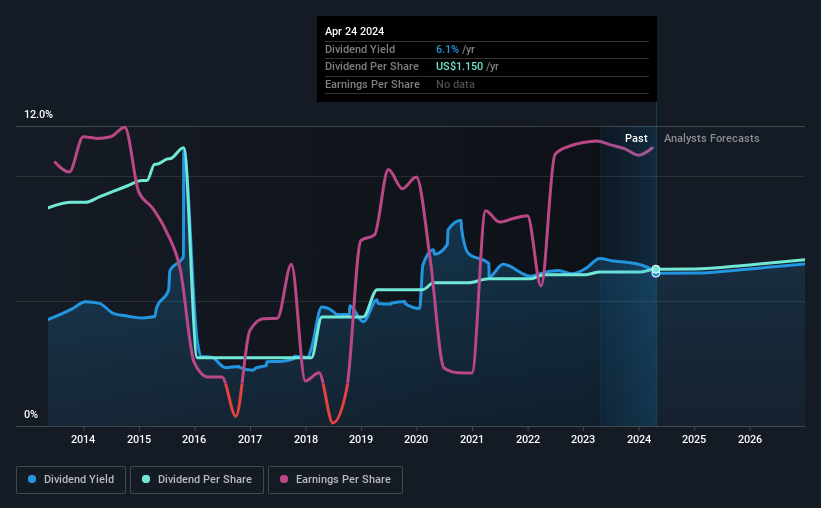Here's Why We're Wary Of Buying Kinder Morgan's (NYSE:KMI) For Its Upcoming Dividend
It looks like Kinder Morgan, Inc. (NYSE:KMI) is about to go ex-dividend in the next three days. The ex-dividend date occurs one day before the record date which is the day on which shareholders need to be on the company's books in order to receive a dividend. The ex-dividend date is important because any transaction on a stock needs to have been settled before the record date in order to be eligible for a dividend. Therefore, if you purchase Kinder Morgan's shares on or after the 29th of April, you won't be eligible to receive the dividend, when it is paid on the 15th of May.
The company's upcoming dividend is US$0.2875 a share, following on from the last 12 months, when the company distributed a total of US$1.15 per share to shareholders. Looking at the last 12 months of distributions, Kinder Morgan has a trailing yield of approximately 6.1% on its current stock price of US$18.81. We love seeing companies pay a dividend, but it's also important to be sure that laying the golden eggs isn't going to kill our golden goose! We need to see whether the dividend is covered by earnings and if it's growing.
Check out our latest analysis for Kinder Morgan
Dividends are typically paid from company earnings. If a company pays more in dividends than it earned in profit, then the dividend could be unsustainable. Kinder Morgan paid out 103% of its earnings, which is more than we're comfortable with, unless there are mitigating circumstances. Yet cash flows are even more important than profits for assessing a dividend, so we need to see if the company generated enough cash to pay its distribution. Kinder Morgan paid out more free cash flow than it generated - 124%, to be precise - last year, which we think is concerningly high. We're curious about why the company paid out more cash than it generated last year, since this can be one of the early signs that a dividend may be unsustainable.
As Kinder Morgan's dividend was not well covered by either earnings or cash flow, we would be concerned that this dividend could be at risk over the long term.
Click here to see the company's payout ratio, plus analyst estimates of its future dividends.
Have Earnings And Dividends Been Growing?
Businesses with strong growth prospects usually make the best dividend payers, because it's easier to grow dividends when earnings per share are improving. If earnings decline and the company is forced to cut its dividend, investors could watch the value of their investment go up in smoke. Fortunately for readers, Kinder Morgan's earnings per share have been growing at 11% a year for the past five years. It's not encouraging to see Kinder Morgan paying out basically all of its earnings and cashflow to shareholders. We're glad that earnings are growing rapidly, but we're wary of the company stretching itself financially.
The main way most investors will assess a company's dividend prospects is by checking the historical rate of dividend growth. Kinder Morgan's dividend payments per share have declined at 3.2% per year on average over the past 10 years, which is uninspiring. Kinder Morgan is a rare case where dividends have been decreasing at the same time as earnings per share have been improving. It's unusual to see, and could point to unstable conditions in the core business, or more rarely an intensified focus on reinvesting profits.
To Sum It Up
From a dividend perspective, should investors buy or avoid Kinder Morgan? Earnings per share have been growing, despite the company paying out a concerningly high percentage of its earnings and cashflow. We struggle to see how a company paying out so much of its earnings and cash flow will be able to sustain its dividend in a downturn, or reinvest enough into its business to continue growing earnings without borrowing heavily. Overall it doesn't look like the most suitable dividend stock for a long-term buy and hold investor.
So if you're still interested in Kinder Morgan despite it's poor dividend qualities, you should be well informed on some of the risks facing this stock. Our analysis shows 2 warning signs for Kinder Morgan and you should be aware of them before buying any shares.
A common investing mistake is buying the first interesting stock you see. Here you can find a full list of high-yield dividend stocks.
Have feedback on this article? Concerned about the content? Get in touch with us directly. Alternatively, email editorial-team (at) simplywallst.com.
This article by Simply Wall St is general in nature. We provide commentary based on historical data and analyst forecasts only using an unbiased methodology and our articles are not intended to be financial advice. It does not constitute a recommendation to buy or sell any stock, and does not take account of your objectives, or your financial situation. We aim to bring you long-term focused analysis driven by fundamental data. Note that our analysis may not factor in the latest price-sensitive company announcements or qualitative material. Simply Wall St has no position in any stocks mentioned.

 Yahoo Finance
Yahoo Finance 
